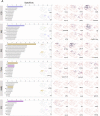Whole-body integration of gene expression and single-cell morphology
- PMID: 34380046
- PMCID: PMC8445025
- DOI: 10.1016/j.cell.2021.07.017
Whole-body integration of gene expression and single-cell morphology
Abstract
Animal bodies are composed of cell types with unique expression programs that implement their distinct locations, shapes, structures, and functions. Based on these properties, cell types assemble into specific tissues and organs. To systematically explore the link between cell-type-specific gene expression and morphology, we registered an expression atlas to a whole-body electron microscopy volume of the nereid Platynereis dumerilii. Automated segmentation of cells and nuclei identifies major cell classes and establishes a link between gene activation, chromatin topography, and nuclear size. Clustering of segmented cells according to gene expression reveals spatially coherent tissues. In the brain, genetically defined groups of neurons match ganglionic nuclei with coherent projections. Besides interneurons, we uncover sensory-neurosecretory cells in the nereid mushroom bodies, which thus qualify as sensory organs. They furthermore resemble the vertebrate telencephalon by molecular anatomy. We provide an integrated browser as a Fiji plugin for remote exploration of all available multimodal datasets.
Keywords: Platynereis dumerilii; automatic segmentation; cell types; gene expression atlas; image registration; machine learning; multimodal data integration; mushroom bodies; telencephalon; volume electron microscopy.
Copyright © 2021 The Authors. Published by Elsevier Inc. All rights reserved.
Conflict of interest statement
Declaration of interests A.A.W. is the founder and owner of ariadne.ai ag.
Figures















Comment in
-
A multimodal whole-body atlas.Nat Methods. 2021 Oct;18(10):1145. doi: 10.1038/s41592-021-01293-2. Nat Methods. 2021. PMID: 34608311 No abstract available.
References
-
- Altun Z.F., Herndon L.A., Wolkow C.A., Crocker C., Lints R., Hall D.H. 2002. WormAtlas.http://www.wormatlas.org
-
- Arendt D., Musser J.M., Baker C.V.H., Bergman A., Cepko C., Erwin D.H., Pavlicev M., Schlosser G., Widder S., Laubichler M.D., Wagner G.P. The origin and evolution of cell types. Nat. Rev. Genet. 2016;17:744–757. - PubMed
-
- Arganda-Carreras I., Sorzano C.O.S., Marabini R., Carazo J.M., Ortiz-de-Solorzano C., Kybic J. In: Beichel R.R., Sonka M., editors. Springer Berlin Heidelberg; 2006. Consistent and elastic registration of histological sections using vector-spline regularization; pp. 85–95. (Computer Vision Approaches to Medical Image Analysis).
Publication types
MeSH terms
LinkOut - more resources
Full Text Sources
Molecular Biology Databases

